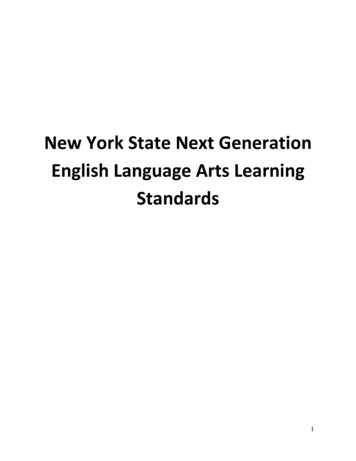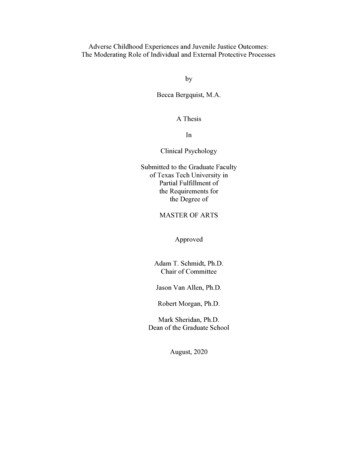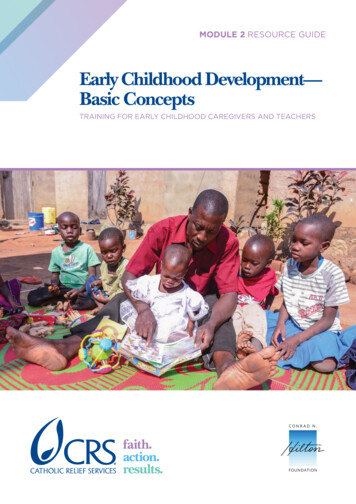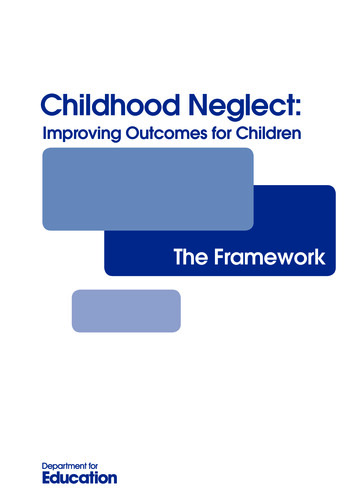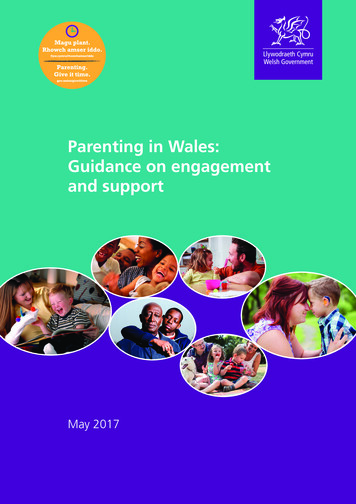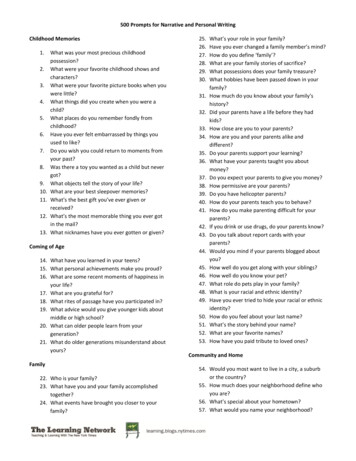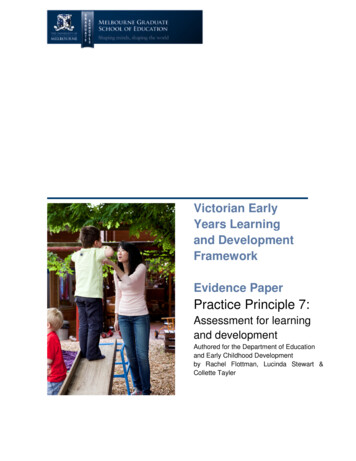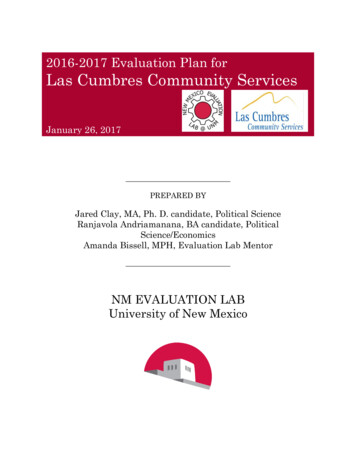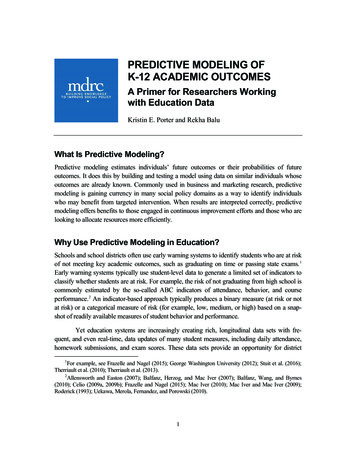
Transcription
TEXAS EDUCATION AGENCY
Early Childhood Outcomes and Prekindergarten Guidelines AlignmentCopyright NoticeCopyright 2011 Education Service Center Region XIII and the Texas Education Agency.Permission for uses: This alignment document was developed at public expense to benefit Texas public school districts, Texasapproved charter schools, Texas regional education service centers and other Texas non-profit Early Childhood entities.Residents of and non-profit entities operating within the State of Texas may freely copy, distribute, create derivative productsbased on and publicly display and perform this alignment document (“use the document”) for the intended beneficiaries. Thisdocument may be used as a resource for educational purposes by educational grantees of federal funds in other states,attributing the material to the copyright owners.Original Early Childhood Outcomes from:The Early Childhood Outcomes CenterCB 8040UNC Chapel HillChapel Hill, NC 27599-8040Texas Education Agency IDEA CoordinationWilliam B. Travis Building1701 N. Congress AvenueAustin, Texas, 787011Education Service Center Region XIIIIDEA Coordination5701 Springdale RoadAustin, TX 78723
Table of ContentsIntroductionWelcome to the Early Childhood Outcomes and Texas Prekindergarten Guidelines AlignmentUnderstanding the Three Early Childhood Outcomes (ECO)Guiding Principles345Utilizing the Early Childhood Outcomes and Texas Prekindergarten Guidelines AlignmentSupporting Instruction for Children with Unique NeedsWriting Developmentally Appropriate Goals and Objectives67Skill DomainsI.Social and Emotional DevelopmentII.Language and CommunicationIII. Emerging Literacy: ReadingIV. Emerging Literacy: WritingV.MathematicsVI. ScienceVII. Social StudiesVIII. Fine ArtsIX. Physical 24131136142Organization of Early Childhood Outcomes and Prekindergarten Guidelines AlignmentThis document addresses the ten domains of the Prekindergarten Guidelines, retaining the same order and color coding.Some of the original text from the Prekindergarten Guidelines has been edited to emphasize the importance and application of these guidelines to a childwith a disability who may be functioning like a younger child. Within the document, the gender of the child and teacher are referred to using “his/her” or“he/she” interchangeably.*Science, Fine Arts, and Technology do not include the developmental continuum column.2
IntroductionWelcome to the Early Childhood Outcomes and Texas Prekindergarten Guidelines AlignmentIn 2005, the Office of Special Education Programs (OSEP) began collecting data to compile information from State Early Intervention and Preschool SpecialEducation programs to report on child and family outcomes. This information about Early Childhood Outcomes (ECO) is required for all children in preschoolprograms for children with disabilities (ages 3 through 5), and in Texas is reported on the Child Outcome Summary Form (COSF). This information is collectedthroughout Texas and other states to reflect the effectiveness of intervention for this age group. In Texas, the summary of data is reported to the TexasEducation Agency (TEA) by each Local Education Agency (LEA) as part of the State Performance Plan (SPP 7).For child outcomes, states are required to report on the percent of preschool children with Individualized Education Programs (IEPs) who demonstrateimproved:1. Positive social-emotional skills (including social relationships);2. Acquisition and use of knowledge and skills (including early language/communication [and early literacy]); and3. Use of appropriate behaviors to meet their needs.The Texas Prekindergarten Guidelines offers detailed descriptions of expected behaviors across multiple skill domains that should be observed in 4- to 5-year-oldchildren by the end of their prekindergarten experience.Statement of PurposeThe purpose of this document is to align each Prekindergarten guideline to one or more of the three Early Childhood Outcomes, and provide educators andfamilies with discussion prompts to explain how each outcome relates to the guideline. The document also provides modifications and adaptations for childrenwith special needs and extends to include a developmental continuum for teachers to use in developing appropriate goals for children who are developmentallyfunctioning below four-year-old expectations, based on the guidelines. Additionally, a separate column is included that lists foundational skills that will lead toexpected three-year-old and four-year-old skills. This will provide a direct link to the Prekindergarten Guidelines and a starting point for the students who are thefarthest away from age-appropriate skill levels when they enter Early Childhood Special Education Programs. The connection of the foundational skills to thePrekindergarten Guidelines will help educators design developmentally appropriate, individualized goals for their youngest learners including students withdisabilities, students learning English as a second language as well as any child who may be at risk educationally.Some children, regardless of their age level, will be at the beginning of the learning continuum (foundational skills), while others will be further along. Childrenwith disabilities may need accommodations and modifications in order to benefit from the guidelines.Early Childhood Outcomes materials adapted from the Early Childhood Outcome Center, online at www.the-eco-center.org (Funding provided through the Office of SpecialEducation Programs, US Department of Education [OSEP]). The Texas Prekindergarten Guidelines is the joint effort of TEA and the University of Texas System (copyright 2008).3
Understanding the Early Childhood OutcomesThe following three Early Childhood Outcomes are considered critical to children becoming active and successful participants across a variety of settings. Allstates are required to report data to the U.S. Department of Education, Office of Special Education Programs on these child outcomes:1. Positive social-emotional skills (including social relationships);2. Acquisition and use of knowledge and skills (including early language/communication [and early literacy]); and3. Use of appropriate behaviors to meet their needs.1. Positive social emotional skills (including social relationships).Making new friends and learning to get along with others is an important accomplishment of the early childhood years. Children develop a sense of whothey are by having rich and rewarding experiences interacting with adults and peers. They also learn that different rules and norms apply to differenteveryday settings and that they need to adjust their behavior accordingly. This outcome involves relating to adults, relating to other children, and forolder children, following rules related to groups or interacting with others. The outcome includes concepts and behaviors such asattachment/separation/autonomy, expressing emotions and feelings, learning rules and expectations in social situations, and social interactions andsocial play.2. Acquisition and use of knowledge and skills (including early language/ communication and early literacy).Over the early childhood period, children display tremendous changes in what they know and can do. The knowledge and skills acquired in the earlychildhood years, such as those related to communication, early literacy, and early numeracy, provide the foundation for success in kindergarten and theearly school years. This outcome involves activities such as thinking, reasoning, remembering, problem solving, number concepts, counting, andunderstanding the physical and social worlds. It also includes a variety of skills related to language and literacy including vocabulary, phonologicalawareness, and letter recognition.3. Use of appropriate behaviors to meet their needs.As children develop, they become increasingly more capable of acting on their world. With the help of supportive adults, young children learn to addresstheir needs in more sophisticated ways and with increasing independence. They integrate their developing skills, such as fine motor skills andincreasingly complex communication skills, to achieve goals that are of value to them. This outcome involves behaviors like taking care of basic needs,getting from place to place, using tools (such as forks, toothbrushes, and crayons); and, in older children, contributing to their own health, safety, andwell-being. It also includes integrating motor skills to complete tasks; taking care of one’s self in areas like dressing, feeding, grooming, and toileting; andacting on the world in socially appropriate ways to get what one wants.The Early Childhood Outcomes Center, November 20094
Principles that Guide this Alignment Every child is unique and capable of learning. All children can learn and will benefit from high expectations that are: age appropriate individually appropriate culturally appropriate Culture and family have a strong influence in a child’s development and learning. Learning is most meaningful when it is integrated across all areas of development. Expectations for children must be guided by knowledge ofchild growth and development based on observations and adefined set of comprehensive standards that are rooted insound research. Children learn through play, active exploration of theirenvironment and thoughtfully planned activities. Quality early learning experiences are essential to andhave a significant impact on a child’s future success.5
Utilizing the Early Childhood Outcomes and Prekindergarten Guidelines AlignmentSupporting Instruction for Children with Unique NeedsAre children with different educational needs expected to meet the Texas Prekindergarten Guidelines?The answer to this question is, “It depends.” Some children who have disabilities that are primarily orthopedic or who have special health needs that may not beaccompanied by significant cognitive impairment (e.g., type 1 diabetes, epilepsy) can be expected to work toward the same level outcomes as their typicallydeveloping peers. Other children may be able to meet these standards with adaptations in materials or instructional strategies. There will also be some childrenwhose cognitive or language impairments are significant enough that goals will need to be modified in order to be realistically achievable for that individualchild. It is important, however, not to assume that a child cannot meet the outcomes in each domain without undertaking a careful appraisal of the individualchild’s capabilities and needs. If the child has a current developmental evaluation report, an existing IEP, or an IEP which is in the process of being revised, thesedocuments can be used to carefully review the Texas Prekindergarten Guidelines and determine which are possible for the child to work toward withoutmodifications or accommodations, which are attainable with some accommodations, and which will require modifications. These decisions require thoughtfulconsideration and should be conducted as part of the team process, including the child’s family and other professionals. Decisions resulting from this processshould be documented in writing so that all members of the team are clear about how the child’s needs will be met, what types of accommodations andmodifications will be made in different domains, and how his or her educational goals will align with the Prekindergarten Guidelines.English Language Learners (ELLs)Children who are English Language Learners (ELLs) may need more intensive language intervention. These children often have language skills that are not asdeveloped as other children their age. This delay may be attributed to acquiring two languages at once rather than a disability. Children who are bilingual oftenmake similar language mistakes as those who have a true language impairment, which can lead to mistaken diagnosis of a disability. Assessment teams mustcarefully consider cultural aspects when gathering and analyzing data to make this decision. This document will focus on children who have a diagnoseddisability (with or without learning English as a second language), but will be helpful for all children with learning differences.Many of the strategies that are suggested in this document that are useful in differentiating strategies for children with different learning needs will also beuseful in teaching ELLs. Additional strategies can be found in the 2008 Texas Prekindergarten Guidelines (Pages 9-12) and throughout the entire Prekindergartendocument indicated by the icon .6
Writing Developmentally Appropriate Goals and Objectives for Students Receiving Special Education ServicesDetermining Where to StartWhen a student is identified in need of special education services, an Individualized Education Program (IEP) is developed. The goals and objectives within theIEP should be written at the developmental level of the student in the domains that the child is functioning below age level. These goals and objectives shouldlink to the Prekindergarten Guidelines, even if at the foundational level. Areas of need that hinder opportunities for inclusion, interfere with social interaction,and affect safety should be targeted first.Measurable annual goals are statements that describe what a student reasonably can be expected to accomplish within a twelve month period.IEP goals and objectives are based on a child’s Present Levels of Academic Achievement and Functional Performance (PLAAFP) There should be a direct relationship between evaluation/assessment information and PLAAFP statements.Choose areas that are most critical to meet the child's needs, enabling the child to achieve expected Prekindergarten skills/concepts.Choose functional skills that are essential to supporting success in the general education environment.Effective teachers recognize the reciprocal, interactive relations among the different areas of development. They recognize, for example, that when a child isemotionally anxious or frustrated, s/he will have more difficulty using adaptive problem-solving skills or following directions in a group activity. When childrenare presented with activities that are too far beyond their capabilities, they are more likely to show avoidance, passivity, or acting-out behavior. On the otherhand, when children are provided with activities that are interesting, challenging, and developmentally appropriate, they experience pride in their success andare eager to learn more.Promoting children’s school readiness will best be achieved when teachers integrate the guidelines and outcomes into their instructional approach by identifyingthe developmentally appropriate skill (or foundational skill) while maintaining a perspective that views the child as an active learner who is continuallydeveloping, adapting, synthesizing new information, and striving toward competence.7
I.SOCIAL AND EMOTIONAL DEVELOPMENT DOMAINEarly experiences influence brain development, establishing the neural connections that provide the foundation for language, reasoning, problem solving, socialskills, behavior and emotional health (Findings from the National School Readiness Indicators Initiative, 2005). While a preschool education should includeactivities that strengthen cognitive skills, it must provide for the development of the social and emotional competencies required for school readiness. Themajority of typically developing children acquire social/emotional skills with little or no formal instruction, and can carry these skills over into play and peerinteractions. When teaching preschool children with disabilities, it cannot be taken for granted that they will naturally learn these skills, even with appropriateSocialSkills SchoolReadinessteacherEmotionalguidance. Manychildrenwith disabilitieswill need direct social skills instruction (Bortoli and Brown, 2008).For some children, especially children with disabilities, providing opportunities to practice social skillswithout explicit teaching may not be enough to improve their social skills. For these children, teachersshould consider (a) providing explicit modeling on not only what a specific social skill is but also how itis used, (b) systematically prompting children's use of appropriate social behaviors, and (c) providingextensive opportunities to practice the social skills that children are taught (Vaughn, Kim, Claire,Hughes, Elbaum, & Sridhar, 2003).In 2006, a national survey of 350 preschool teachers conducted by the Horizon Research Corporationfound that Social Skills trumped academic abilities. The survey revealed that parents who focused onsocial development such as following directions, communication and getting along with other childrenwith their preschoolers, rather than academic and technical skills such as numbers and letterrecognition, had children who were more prepared to enter a school environment.USA Today published a survey of 800 kindergarten teachers who ranked social skills above academicskills (Neyman & Gonzalez, 2004).8
I.SOCIAL AND EMOTIONAL DEVELOPMENT DOMAINA. Self Concept SkillsCentral to understanding emotional development is the idea of self concept–an increasing level of conscious awareness of one’s feelings, thoughts, abilities,likes, and dislikes, as well as awareness of one’s body in space. Preschool children’s emerging ability to perceive these aspects of themselves at a conscious leveldistinguishes them from toddlers, who lack such awareness. Children begin to generate multiple answers to the question “Who am I?” which is an essentialaspect of becoming competent in related areas such as self control and social/friendship skills.Early ChildhoodOutcome andGuiding QuestionsEnd ofPrekindergartenYear OutcomesDevelopmental ContinuumFoundational Skills(48 and 36 months)(may lead to ageappropriate functioning)Outcome 1:social relationshipsI.A.1.Child is aware ofwhere own body isin space, respectspersonalboundaries.The 48 month old child:builds competence in controllingown body movements (such asbalancing, sitting still, starting andstopping in response to requests).stays in designated personal spacewithout intruding upon others’(e.g., stays in own seat at lunchtable without kicking feet orleaning against neighboringchildren). How does thechild respond totouch fromothers? Does the childnegotiatedifferent areas ofthe room withouttripping or fallingor stepping onthings?Outcome 1:social relationships Does the childseek out othersafter anaccomplishment?How?I.A.2.Child showsawareness of areasof competence anddescribes selfpositively in what heis able to do.The 36 month old child:needs visual reminders ofboundaries both within theclassroom and with personal space.can play alongside another childbut will still grab at others’materials if it is something thatthey want.The 48 month old child:can identify own physicalcharacteristics and indicate somelikes and dislikes when prompted.describes self using basiccharacteristics (hair color, eyecolor, gender).describes self using personal9Differentiation of Instruction for Childrenwith Learning DifferencesFollows a person’smovement with theireyesExplores own face, eyesand mouth with handTolerates beingphysically near othersPlays alongsideanother child withadult proximity andhelpEnjoys simple back andforth games such ashide and seekThe teacher:uses mats or other special spots to designate achild’s personal space in circle time.uses cube chairs for children who needphysical reminders of their space.creates clear paths through classroom withdesignated areas for waiting (e.g., footsteps onfloor near bathroom, water fountain, andwhere to wait in line).uses trays or tape to define table work areas.uses visual examples when talking aboutpersonal space such as “popping one’s bubblespace”.Child can identify ownphysical characteristicsand indicate some likesand dislikes whenpromptedRecognize themselvesin mirrors and inpicturesThe teacher:acknowledges children’s efforts, providingsupport when needed.has a variety of skin tone crayons, markers,paper and dollsprovides a mirror in the home center and atcircle time when appropriate.reads aloud and discusses books about self
Early ChildhoodOutcome andGuiding QuestionsEnd ofPrekindergartenYear Outcomes Does the childtend to choseonly activities thathe is familiarwith? Does the childpush away at anadult trying tohelp, or say, “Ican do it!”?Outcome 1:social relationships Is the childtentative whenapproaching newsituations or timidwhen trying newthings? How does thechild ask for help?Outcome 1:social relationships Will the child tryto reach forsomething againif his firstattempt isunsuccessfully? Will the childturn an insetpuzzle pieceDevelopmental ContinuumFoundational Skills(48 and 36 months)(may lead to ageappropriate functioning)preferences.describes self in terms of being amember of different communities(family, classroom, school).Will repeat actionswhen applaudedThe 36 month old child:identifies self by gender.talks about all the things he can do;may show shame at not being ableto do something.can tell what eyes, ears, and noseare used for.I.A.3.Child showsreasonable opinionof his own abilitiesand limitations.The 48 month old child:may overestimate orunderestimate own abilities.proud of accomplishments(boasts), believes that she can doanything, may be argumentative.Sense of pride inaccomplishments, maycry at failure toaccomplish goalThe 36 month old child:shows caution and looks to adultbefore attempting something new.I.A.4.Child showsinitiative inindependentsituations andpersists inattempting to solveproblems.The 48 month old child:shows initiative in trying newactivities, but may not persist insolving problems.The 36 month old child:can attend to activities or storiesfor brief periods of time (5–10minutes). She will stay involvedlonger if the activity is a favoriteone.usually wanders away from an10Child works to dothings by self, persistsin tasks he findschallengingWants praise for goodperformancePushes for autonomybut still needs to stay intouch with caregiverDifferentiation of Instruction for Childrenwith Learning Differencesawareness.points out observations of progress inchildren’s growing competence using specificpraise.places photos of children next to their artworkor displayed on a bulletin board to helpreinforce children’s images of themselves ascompetent learners.The teacher:sets appropriate safety limits for children’s agelevel.provides help kindly when requested.encourages children to do as much as they areable independently.points out and compliments children whenthey use good judgment (“Jasmine, I’m glad tosee you carrying those scissors so carefully.”“Thank you, Derrick, for wiping up that spilledwater so no one will slip and fall.”).models and encourages practice of self-helpskills child has not yet mastered.The teacher:provides a variety of learning centers andactivities that meet the needs and interests ofdifferent children.gives children opportunities to makeindependent decisions about which learningcenter or materials to work with, using visualsto aide children in selections.models appropriate use of materials forindependent work or play.comments on the contributions of children inactivities, tasks, and play.
Early ChildhoodOutcome andGuiding Questionsaround to makeit fit?Outcome 2:knowledge and skills Tell me about atime when hetried to solve aproblem (e.g.,overcome anobstacle/probleminterfering withsomethingimportant tohim). What did hedo?End ofPrekindergartenYear OutcomesDevelopmental ContinuumFoundational Skills(48 and 36 months)(may lead to ageappropriate functioning)activity when encountering aproblem rather than trying to solvethe problem.requires very specific help inproblem solving and explicitphysical guidance when followingsuggestions.11Differentiation of Instruction for Childrenwith Learning Differencesencourages children to solve problems andpersist at challenging tasks.
I.SOCIAL AND EMOTIONAL DEVELOPMENT DOMAINB. Self ControlPreschool children feel safer and function more successfully in the classroom when rules and routines are consistently followed. A well-organized classroomwith well-prepared activities helps children extend their attention span and build self-control and personal responsibility. As children experience new socialsituations when playing with peers, guidance from teachers will enable them to learn acceptable ways of negotiating friendships, taking turns, following rules,and working well with others.1. Behavior ControlEarly ChildhoodOutcome andGuidingQuestionsEnd ofPrekindergartenYear OutcomesDevelopmental ContinuumFoundational Skill(48 and 36 months)(may lead to age appropriatefunctioning)Outcome 1:social relationshipsI.B.1.a.Child follows classroomrules and routines withoccasional remindersfrom teacher.The 48 month old child:can follow instructions givenin a small group.may play familiar games withpeers and follow the ruleswith little adult intervention.finds established routinesvery comforting.feels safer and better able toparticipate when rules areclear and followedconsistently.can follow simple rules andprocedures with gentlereminders. Does the childshowawareness ofroutines?How? How does thechild respondto transitions,routines oractivities? Arethe reactionsdifferent forfamiliar vsunfamiliartransitions ordifferentacross settingsor withdifferentpeople? How does thechild respondwhen given aAllows adult to movehim/her throughroutinesFollows classroomroutines withassistance such asreminders, picturecues, or physical helpThe 36 month old child:begins to internalize rules,but has difficulty transferringrules across time andsettings.participates in thedevelopment of classroomrules.transitions from one activityto another.12Differentiation of Instruction for Children withLearning DifferencesThe teacher:involves children in creating classroom rules andexpectations so they feel sense of ownership.consistently refers to and uses the rules androutines to structure the day.establishes signals (finger plays, songs, chants, etc.)to help children transition from one activity toanother.uses a daily schedule chart to help children followthe day’s activities.
Early ChildhoodOutcome andGuidingQuestionsEnd ofPrekindergartenYear Outcomesdirection? How does thechild respondwhencorrected byan adult?Outcome 1:social relationships Does the childparticipate inclean-uproutines? How does thechild treatclassroommaterials (e.g.toys, furniture,computer, etc.)Outcome 1:social relationships Is the childable to engagein simple socialskills likeI.B.1.b.Child takes care of andmanages classroommaterials.I.B.1.c.Child regulates his ownbehavior withoccasional remindersor assistance fromteacher.Developmental ContinuumFoundational Skill(48 and 36 months)(may lead to age appropriatefunctioning)comments on the sequenceof the day’s events, “Aftercenters it’s time to gooutside.”goes to the daily schedulechart and points out whatcomes next.The 48 month old child:is able to manage a smallnumber of materials withsupport.cleans up and puts materialsaway in appropriate places(places a puzzle back into itslabeled spot).puts away his belongings inhis personal space.The 36 month old child:uses markers/crayons onpaper rather than othersurfaces.begins to take care of books(e.g., turning pages slowly).beginning to learn to takecare of materials and putthings back where theybelong.needs modeling, guidance,and many reminders to do so.The 48 month old child:needs adult guidance to helpmanage her behavior.discriminates appropriateroles and behaviors.has internalized rules aboutdo‘s and don’ts.13Differentiation of Instruction for Children withLearning DifferencesCan follow visual cues(matching the object topicture) where materialsare put away onshelves/binsMay throw materialswhen done and check inwith caregiver to see ifthey noticed (showingbeginning understandingthat this is notacceptable behavior)Can locate the assignedand labeled area fortheir personalbelongings with someguidance and repetitivepracticeThe teacher:provides demonstrations and reminders ofappropriate use of materials.establishes signals (clean-up song) to help childrenclean up.provides adequate time for cleaning up materials.labels materials to make them accessible forchildren.uses pictures and print to label shelves for easierclean up and storage of classroom materials.provides a space for children to store personalbelongings.introduces new materials and shows children howto use them before placing the materials in activitycenters.Accepts adult solution toresolve a conflictFollows single stepdirectionsEngages in self-tattlingShows awareness ofadults wishes andThe teacher:establishes and uses signals to help transition fromone activity to another.responds to a child’s request for assistance in atimely manner.uses center signs to help structure the number ofchildren in a center at any given time.
Early ChildhoodOutcome andGuidingQuestionsEnd ofPrekindergartenYear Outcomessharing andbeing kind? How does thechild reactwhenfrustrated orwhen angry?Developmental ContinuumFoundational Skill(48 and 36 months)(may lead to age appropriatefunctioning)expectationsConscious of adultapproval/disapprovalmay do something eventhough he knows it is wrong.may argue with adult aboutwhat he is supposed to do.Differentiation of Instruction for Children withLearning Differencesreads aloud and discusses books that showcharacters regulating behavior.intervenes promptly when child’s behavior beginsto escalate.The 36 month old child:needs adult support tocontrol impulses.begins to recognize when sheneeds some help to solve aproblem.communicates appropriatelyto make needs known.waits for her turn (e.g., waitspatiently at the waterfountain for a classmate tofinish drinking; selectsanother learning center whenthe learning center of her firstchoice is full).refrains from impulsiveresponding (waits turn to b
should be documented in writing so that all members of the team are clear about how the childs needs will be met, what types of accommodations and modifications will be made in different domains, and how his or her educational goals will align with the Prekindergarten Guidelines.
